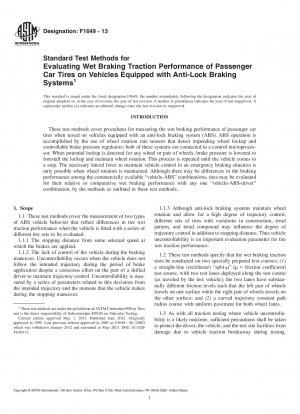ASTM F1649-13
Standard Test Methods for Evaluating Wet Braking Traction Performance of Passenger Car Tires on Vehicles Equipped with Anti-Lock Braking Systems
- Standard No.
- ASTM F1649-13
- Release Date
- 2013
- Published By
- American Society for Testing and Materials (ASTM)
- Status
- Replace By
- ASTM F1649-20
- Latest
- ASTM F1649-20
- Scope
5.1 Braking traction is an important factor in vehicle control especially on wet pavements. These test methods permit an evaluation of tires for their relative or comparative performance on an ABS-equipped vehicle. See Annex A1 for background information for interpretation of results and meaningful evaluation of tire design features for their influence on wet traction performance.
5.2 Although stopping distance is important for vehicle control, the ability to steer the vehicle on a selected trajectory is equally or, in some instances, more important. The wet traction capability of tires influences both of these measured parameters since the tires are the link between the ABS and the pavement and provide the traction or tire adhesion level that permits the ABS to function as intended.
5.3 The absolute values of the parameters obtained with these test methods are highly dependent upon the characteristics of the vehicle, the design features of the ABS, the selected test pavement(s), and the environmental and test conditions (for example, ambient temperature, water depths, test speeds) at the test course. A change in any of these factors may change the absolute parameter values and may also change the relative rating of tires so tested.
5.4 These test methods are suitable for research and development purposes where tire sets are compared during a brief testing time period. They may not be suitable for regulatory or specification acceptance purposes because the values obtained may not necessarily agree or correlate, either in rank order or absolute value, with those obtained under other conditions (for example, different locations or different seasonal time periods on the same test course).
1.1 These test methods cover the measurement of two types of ABS vehicle behavior that reflect differences in tire wet traction performance when the vehicle is fitted with a series of different tire sets to be evaluated.
1.1.2 The lack of control of the vehicle during the braking maneuver. Uncontrollability occurs when the vehicle does not follow the intended trajectory during the period of brake application despite a conscious effort on the part of a skilled driver to maintain trajectory control. Uncontrollability is measured by a series of parameters related to this deviation from the intended trajectory and the motions that the vehicle makes during the stopping maneuver.
1.1.3 Although anti-lock braking systems maintain wheel rotation and allow for a high degree of trajectory control, different sets of tires with variations in construction, tread pattern, and tread compound may influence the degree of trajectory control in addition to stopping distance. Thus vehicle uncontrollability is an important evaluation parameter for tire wet traction performance.
1.2 These test methods specify that the wet braking traction tests be conducted on two specially prepared test courses: (1) a straight-line (rectilinear) “split-µ” (µ = friction coefficient) test course, with two test ......
ASTM F1649-13 Referenced Document
- ASTM E1136 Standard Specification for A Radial Standard Reference Test Tire
- ASTM E1337 Standard Test Method for Determining Longitudinal Peak Braking Coefficient of Paved Surfaces Using Standard Reference Test Tire
- ASTM E274 Standard Test Method for Skid Resistance of Paved Surfaces Using a Full-Scale Tire
- ASTM E303 Standard Test Method for Measuring Surface Frictional Properties Using the British Pendulum Tester
- ASTM E501 Standard Specification for Standard Rib Tire for Pavement Skid-Resistance Tests
- ASTM E524 Standard Specification for Standard Smooth Tire for Pavement Skid-Resistance Tests
- ASTM E965 Standard Test Method for Measuring Pavement Macrotexture Depth Using a Volumetric Technique
- ASTM F1046 Standard Guide for Preparing Artificially Worn Passenger and Light Truck Tires for Testing
- ASTM F1572 Standard Test Methods for Tire Performance Testing on Snow and Ice Surfaces
- ASTM F1650 Standard Practice for Evaluating Tire Traction Performance Data Under Varying Test Conditions
- ASTM F1805 Standard Test Method for Single Wheel Driving Traction in a Straight Line on Snow- and Ice-Covered Surfaces
- ASTM F1806 Standard Practice for Tire Testing Operations-Basic Concepts and Terminology for Reference Tire Use
- ASTM F2493 Standard Specification for P225/60R16 97S Radial Standard Reference Test Tire
- ASTM F457 Standard Test Method for Speed and Distance Calibration of a Fifth Wheel Equipped With Either Analog or Digital Instrumentation
- ASTM F538 Standard Terminology Relating to the Characteristics and Performance of Tires
ASTM F1649-13 history
- 2020 ASTM F1649-20 Standard Test Methods for Evaluating Wet Braking Traction Performance of Passenger Car Tires on Vehicles Equipped with Anti-Lock Braking Systems
- 2013 ASTM F1649-13 Standard Test Methods for Evaluating Wet Braking Traction Performance of Passenger Car Tires on Vehicles Equipped with Anti-Lock Braking Systems
- 1996 ASTM F1649-96(2003) Standard Test Methods for Evaluating Wet Braking Traction Performance of Passenger Car Tires on Vehicles Equipped with Anti-Lock Braking Systems
- 1996 ASTM F1649-96e1 Standard Test Methods for Evaluating Wet Braking Traction Performance of Passenger Car Tires on Vehicles Equipped with Anti-Lock Braking Systems

Copyright ©2024 All Rights Reserved